Oct 28, 2016Advancements in radio frequency identification during the past few years have resulted in more—and bigger—deployments. Rising RFID adoption rates worldwide and across industries can be attributed in large part to lower costs, more reliable and powerful technologies, best practices for implementation and a better understanding of the business case.
Yet, many organizations continue to grapple with RFID projects. To learn why, RFID Journal asked readers to contribute their thoughts and experiences through a survey, conducted in May. We sent questionnaires to all end users and potential end users of RFID in our database and received 140 responses. Roughly half the respondents reside in the United States or Canada, 21 percent in Europe, 11 percent in Latin America, 10 percent in the Asia-Pacific region, and 8 percent in the Middle East and Africa.
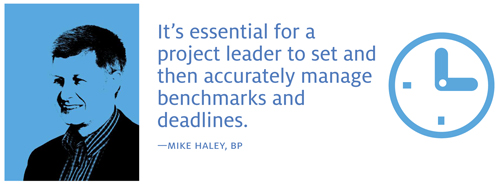
Survey respondents were self-selecting, though they cut across a wide range of industries and include government entities. While the respondents do not necessarily represent the global pool of companies interested in deploying RFID, the survey results provide some interesting insights into the views and practices of organizations researching and using RFID today. In addition, we followed up with some respondents to better understand how their organizations are using RFID, and what challenges and opportunities lie ahead.
The State of Adoption
Before any organization deploys RFID, experts say, it must develop a strategic plan. That includes understanding the conditions in which a business competes and how RFID can change the stakes, advised Bill Hardgrave, dean of Auburn University's Harbert College of Business and founder of the RFID Lab, in our Jan./Feb. cover story, Listen Up, Laggards! Many organizations are heeding this advice—50 percent of respondents said they have been reading about, learning about or generally following RFID technologies for more than four years, 15 percent for three to four years, and another 15 percent for two to three years.
Interest in RFID continues to grow: 9 percent of respondents said they have been researching RFID for one to two years, and nearly 12 percent said they've been researching RFID for less than one year.
The survey indicates that many companies are still figuring where and how best to employ RFID. Only 13 percent of respondents said they have deployed an RFID solution at all their facilities, while just over 30 percent said they have deployed a solution at some of their facilities, and 7 percent said they've completed a pilot and are planning a rollout. Roughly 12 percent said they are either completing an RFID proof of concept or running or planning to run a pilot. At the same time, 32 percent of respondents said they are researching RFID solutions but have not yet implemented the technology, while 6 percent have no plans for RFID within the next two years.
All this plays out in the real world in different ways. Fashion firm Tahari ASL, for example, is in the process of implementing RFID at its distribution center. The company sells online and through major clothing retailers, such as Nordstrom and Macy's. "Our goal is to speed up receiving and packing processes," says Nihad Aytaman, VP of information technology for parent company Elie Tahari. Aytaman says 100 percent of its garments are being tagged at the source of manufacture. The company also hopes to reduce if not eliminate human error while merchandise is in transit, by electronically recording shipments to address shortage claims from department stores, he says.
At Texas Health Resources, the largest nonprofit faith-based health-care delivery system in North Texas and one of the largest in the United States, the focus is on expanding the use of RFID. "We are already using RFID technology and have been for some years," says Kathi Cox, senior director, system integration & innovation. The organization launched its RFID initiative in 2008 to track assets in one of its facilities. This helps technicians and nurses spend less time looking for equipment and more time treating patients, she notes. In 2012, Texas Health Resources undertook a more comprehensive RFID deployment spanning assets, patients and staff, and it is just beginning to expand the program to other facilities in its 14-hospital system.
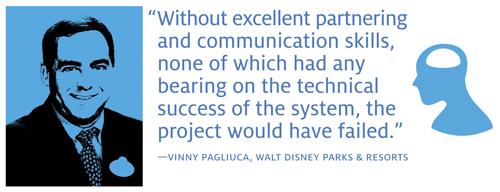
Government, too, is finding value in RFID. The U.S. Department of Energy, for example, is currently tapping the technology to track and monitor the condition of high-value materials, including radioactive shipments. RFID also helps the agency understand how and where it stores materials and their impact on the environment, says James M. Shuler, manager of the DoE Packaging Certification Program. The agency is field-testing RFID systems that can be used with robots to measure radiation at its Argonne National Laboratory and Nevada Nuclear Security Site. These systems could deliver far better environmental monitoring at a lower price point, all while improving safety, Shuler adds.
Among the respondents whose organizations have deployed RFID, a whopping 73 percent said they are pleased with their RFID solution. But 27 percent said they're still struggling to make the system work the way they want it to.
Texas Health Resources' Cox sees RFID as a way to build a more efficient business and IT framework through automation, including detecting malfunctioning equipment and spotting problems sooner. "Ultimately, the utopia is to have an enterprise solution that allows us to leverage all of our resources—including people and assets—across all facilities," she says. "We want to compare workflows between like-sized facilities, so we can incorporate best practices based on real-time location data rather than inferences." But, she notes, the accumulated costs associated with batteries, tags, hardware upgrades and software can prove formidable. "RFID is not a system you can set and forget," she says. "It's important to validate results against an industry that is constantly being asked to reduce its costs."
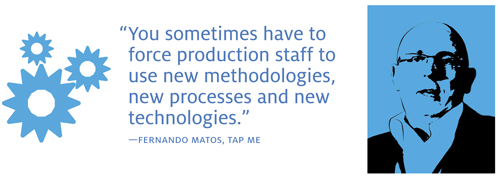
The move from paper to electronic systems is nothing short of critical at a French UTC Aerospace Systems site, which manufactures primary flight actuators used in commercial, regional, business and military aircraft, helicopters and other platforms. "Using paper documentation and handwritten data increases the risk of lost traceability, which is mandatory," says Antonio Cortes, SOA manufacturing engineering manager. Paper and manual processes also slow access to information of manufactured parts. The company is in the process of implementing an RFID pilot on an assembly line. "Our first goal is to achieve paperless manufacturing processes, with complete electronic data recording," Cortes says. Beyond that, the company hopes to expand RFID to suppliers and customers.
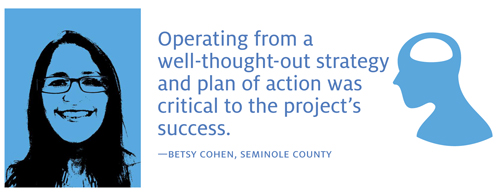
Since 2015, Moods of Norway's clothing suppliers have been RFID-tagging all garments sold by 15 stores the Norwegian retailer operates. The company's retail director, Hans Petter Hübert, says 80 percent of the value has come with 20 percent of the effort. "We have addressed the 'easy' but most important part, which is to secure high-inventory accuracy," he says. But, he adds, evolving toward the future digital store and implementing RFID is complicated because "it's difficult to identify any business case without trial and error. We are dealing with rapid market changes and rapid changes in customer behavior." In the future, he would like to use RFID data to gain more insight into customers' shopping habits.
The expense of RFID and the resources required to operate the system—particularly a fixed or always-on solution—are ongoing factors, Hübert says. But, he adds, in the months and years ahead, RFID will be part of a framework that will allow the company to operate in a more "customer-centric" way.
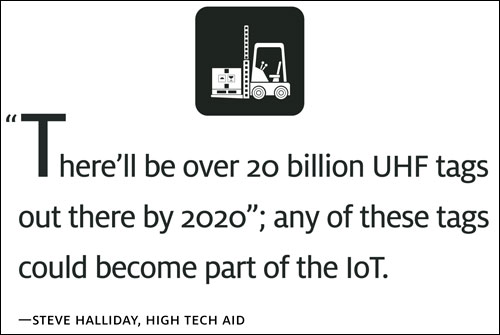
Tackling the Challenges
For many companies considering or piloting RFID, cost and implementation issues still loom large. Nearly 28 percent of respondents said the cost of tags, readers, software and installation services remains too high. But 29 percent of respondents said costs are not a barrier to the use of RFID technologies.
Of the companies that have deployed RFID systems, 57 percent said the final system cost what their RFID provider estimated it would cost, and 43 percent of respondents said the system did not meet estimated costs or they didn't know if it did.
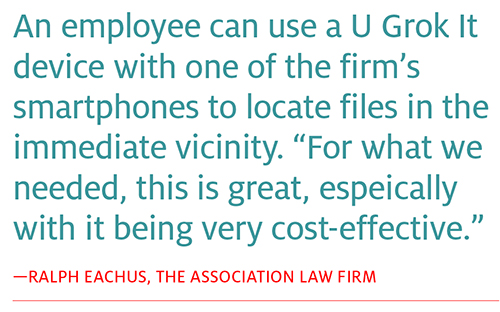
When asked why their company has not deployed an RFID solution, 54 percent of respondents said they are concerned about the cost of the system and potential payback. "Cost is a factor," Elie Tahari's Aytaman says. "Each RFID tag is costing us an additional 10 cents. Tag prices do need to come down for mass acceptance."
Consolidated Contractors Co. (CCC), an Athens, Greece-based construction firm, has been using RFID for 10 years, says Firas Hijazi, manager of information systems for projects automation and controls. "We implemented RFID for spool management, yard management, access control and fuel management," he says. The company would like to make the use of RFID a standard on all projects but, he adds, cost and interference issues remain barriers.
Identifying RFID hardware, software and service providers remains a challenge for many companies. Only 24 percent of respondents said they have a solid understanding of the products available and the companies that offer them, 54 percent said they are familiar with a few companies, and 22 percent said they are unfamiliar with most RFID companies and their offerings.
Another barrier to deployment is the fact that companies often have to buy tags from one vendor, readers from another, and software and integration services from a third. Nearly 49 percent of respondents said it would be simpler and less risky to buy an integrated solution from a single provider. In addition, 22 percent of respondents said their company has not deployed an RFID solution because it has not found an off-the-shelf solution that meets their needs.
Still, 67 percent of respondents said they found a provider that could design and install an RFID system for the company fairly quickly. Only 16 percent of respondents said they searched a long time before finding the right provider, and 18 percent said they wound up developing some aspects of the system internally. UTC Aerospace Systems is one of the firms searching for an RFID provider. "We are not specialists of this technology," Cortes says. "We are facing issues finding technical and legal support to introduce this technology."
Most respondents, just under 71 percent, said their RFID provider or systems integrator had experience implementing similar systems for other companies in their industry. And 78 percent of respondents said several issues arose during their deployment, but their systems integrator was able to address those concerns quickly. Only 8 percent of respondents said they had to bring in a third party to address issues, and 14 percent said no problems arose. Still 24 percent of respondents were concerned about the ability to deploy a solution that would be 100 percent reliable.
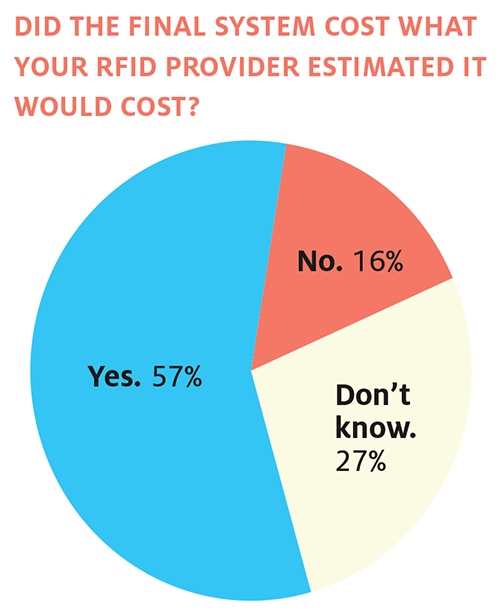
Technical challenges vary depending on the industry. The retail sector, for example, is using passive ultrahigh-frequency EPC Gen 2 RFID tags to track items. At Elie Tahari, the technical challenges involve "calibration and getting the antennae to achieve 100 percent read accuracy as garments flow by at high speed," Aytaman says. "We are currently testing the inbound process and calibrating antennae for optimum capture."
Construction services firm CCC would like to use RFID to assemble components, including fabricated spools, within a warehouse and at other locations, but interference from metal components and pipes remains an issue, Hijazi says.
For food manufacturers, environmental conditions can be a deterrent. Nestlé, for example, has explored using RFID for track and trace, but products with moisture—including liquids and frost on packages—attenuate signals while metal containers block transmissions, explains Thomas A. Doney, expert engineer for the company's packaging competence unit in the Americas. "Materials and finished goods storage areas in the factory are not set up for RFID deployment," he says. Cost, he adds, is also an issue for a consumer products company.
Beyond technical issues, an RFID solution often impacts the way a company conducts business and how employees do their jobs. While 8 percent of respondents said their solution provider or systems integrator did not understand their business, 65 percent reported that their provider helped them use RFID to streamline processes and/or improve workflows. Another 27 percent of respondents said they had already done this work before engaging a provider.
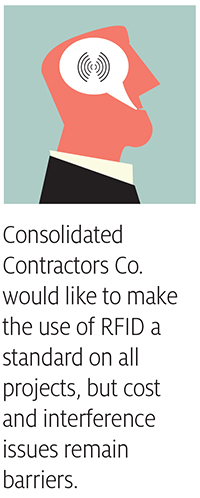
RFID Users Share Their Wish Lists
Lower costs and plug-and-play systems top many RFID end users' wish lists. We asked some executives what product developments they'd like to see. Here's what they told us.
"For all software and hardware to come together and work in harmony for simpler implementation," says Elie Tahari's Aytaman. "All RFID tags and readers must work as accurately and flawlessly as bar codes. Right now, we still see differences in tag quality and readability."
If RFID worked seamlessly, he says, the retailer could use it to achieve a number of benefits: "First, speeding up the receipt process by eliminating manual processes. Second, maintaining better inventory accuracy with fast cycle counts using handheld RFID guns. Third, speeding packing processes by eliminating scanning (RFID readers under the packing tables would detect what goes into the carton). This would also eliminate double scanning and short shipping at the packing station, since each RFID tag is, in effect, a serial number. Fourth, an electronic record of what is loaded into the truck, to fight short shipment claims."
Texas Health Resources' Cox would like to see "more champions who understand all the benefits," she says. "Assets are easy, low-hanging fruit and how you justify the initial costs. The real value of RFID is all the things you can do with it that don't necessarily generate a hard ROI. Without champions who truly understand the technology and what its capabilities are, it is hard to move things forward."
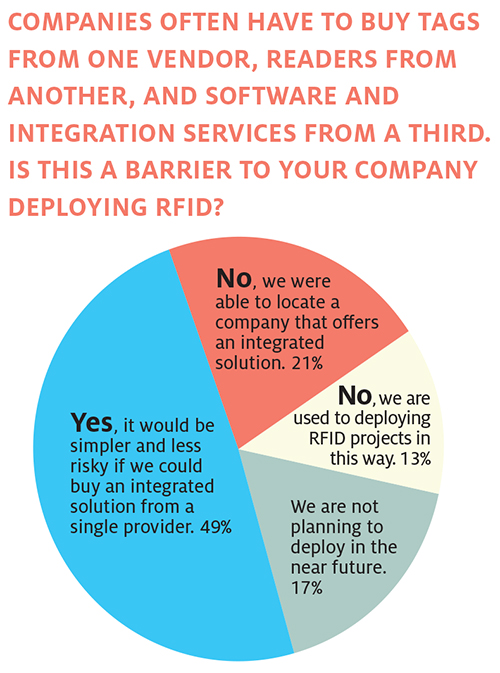
On the technology side, Cox would like "one-use active tags for patients built into their armbands, which would ping to show changes in location. This could help us with infection control, patient flow, association between patient and asset, or even association between patient and staff member," she says.
"Today's tag is a larger footprint that has to be attached to the patient via a wristband or clip," Cox states. "It takes resources to ensure the tags are cleaned before use on each patient. Sometimes we lose them because staff members forget them and/or they are underneath a coat and don't set off an alarm when a patient is discharged. The expense of the lost tags is significant in an industry in which we are constantly trying to reduce costs and reimbursements are declining."
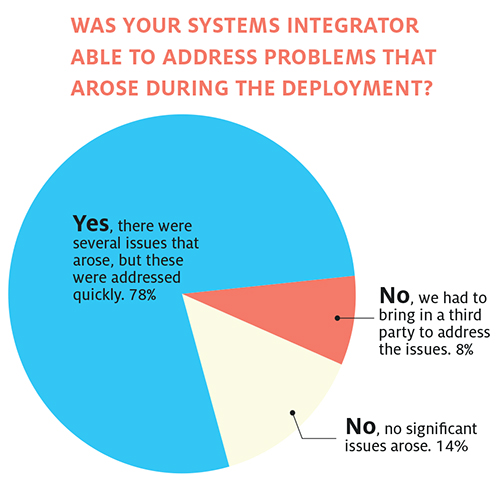
The DoE's Shuler says he would welcome "low-cost, miniature gas-composition sensors for various gases. A package of certain types of radioactive materials, for example, may give off hydrogen gas as radioactive decay occurs," he explains. "With an H2 sensor, we could monitor the pressure buildup and take action before the pressure could harm the package seals. Also, if we could detect different gases—for example, explosive sewer gases in sewers, H2S gases for the oil and gas industry, sarin gas for military arms inspectors in certain countries, combustion gases for smoke jumpers and firefighters—we could monitor for almost everything using either our SAV-EM, ARG-US, RAMM, ACTS or InPac RFID solution, and transmit that information anywhere in the world instantaneously via 3G, 4G, Wi-Fi or various satellite systems to the appropriate individuals' computers or cell phones for action."
"Lower-cost tags that have a longer reading range and less interference with metal," says CCC's Hijazi when asked what tops his RFID wish list. "We have used RFID tags for two major types of implementations: pipe yard management for fabricated spools and employees' access control to the site. In the fabricated spools implementation, the read range was less than the theoretical lab reading range, since there is interference from the metal—especially if the spools are stacked or too close to each other.
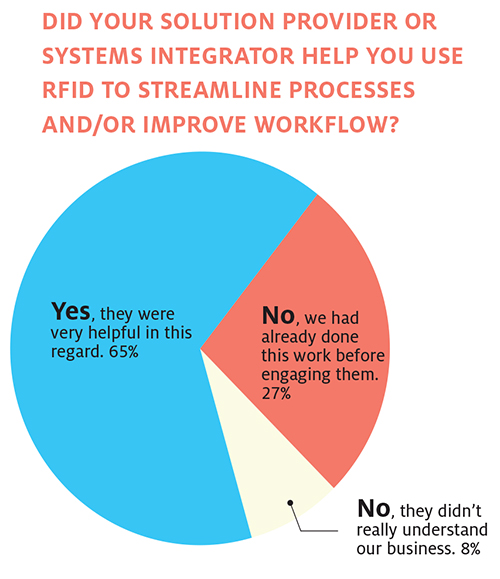
"For access control, there were two major sources of interference," he says. "Since tag reading takes place while the employees are on board a bus, in their seats, there is interference from the metal on the sides of the buses and from the water inside the employees' bodies, since they sit next to each other and have their tags in their pockets or hanging from their neck.
"In the case of the fabricated spools yard management, you can have the reader installed on a drone that can fly over the yard and collect readings from the tags," he adds. "This is faster than the handheld or the car-mounted readers. Similarly, you can read the tags of the employees and track their locations simply by flying the drone above the construction site."
Moods of Norway's Hübert says he would like "a robust, always-on solution that would require little or no manual interaction from store personnel."
"The information flow must become more fluid," says UTC's Cortes. "That includes the ability to comprehensively view physical movement, identify differences between flows and understand details, such as who has completed an operation or task or where are parts that are urgently needed." This, he adds, may require further advances in software and more advanced integration across various systems and data repositories.
Illustrations: iStockphoto
